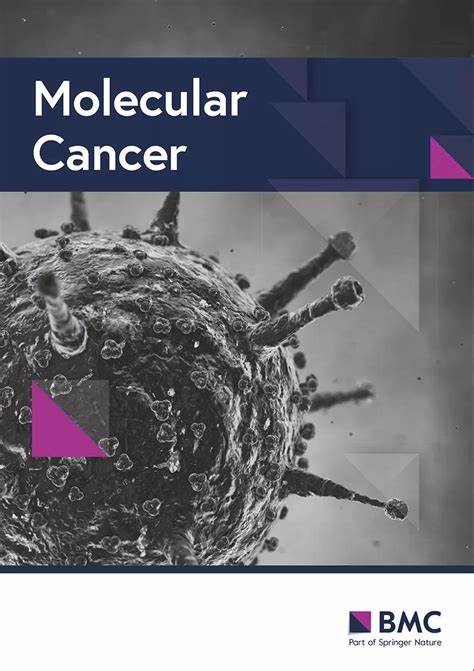在 KRASG12D 驱动的非小细胞肺癌中,PI3K-AKT-mTOR 轴始终是一种治疗依赖因素
IF 27.7
1区 医学
Q1 BIOCHEMISTRY & MOLECULAR BIOLOGY
引用次数: 0
摘要
KRASG12C 和 KRASG12D 抑制剂直接针对非小细胞肺癌(NSCLC)中突变最严重的癌蛋白,是非小细胞肺癌(NSCLC)和一般癌症在转化方面的重大突破。然而,对这些小分子的耐药性凸显了对合理组合伙伴的需求,这就需要对 KRAS 突变异构体下游的信号传导进行深入了解。我们对比了 KrasG12C 和 KrasG12D 基因工程小鼠模型(GEMMs)的肿瘤发生情况。为了证实研究结果并确定突变亚型的特异性依赖性,我们通过 RNA 测序分析了 KrasG12C 和 KrasG12D 启动和适应的同源模型。我们还采用了已确诊的 KRAS 突变 NSCLC 细胞系模型,并通过药理抑制确定了治疗漏洞。我们分析了晚期 KRASG12C 或 KRASG12D 突变 NSCLC 患者生存结果的差异。与 KRASG12C 相比,KRASG12D 在体内表现出更高的效力,表现为更快的肺肿瘤形成和 KRASG12D GEMMs 存活率降低。在同源启动模型中再现的这种增效与 PI3K-AKT-mTOR 信号转导增强有关。然而,在体外和体内肿瘤发生的后期阶段,KRASG12C 的致癌能力和下游通路激活与 KRASG12D 相当,这与患者的临床结果相似。尽管如此,已建立的 KRASG12D NSCLC 模型更依赖于 PI3K-AKT-mTOR 通路,而 KRASG12C 模型则依赖于 MAPK 通路。具体来说,体外和体内抑制 AKT 会增强对 KRASG12D 的抑制作用。我们的数据凸显了一种独特的联合治疗脆弱性,并建议使用直接 KRAS 抑制剂的联合治疗方法的患者选择策略应:i)针对单个 RAS 突变体的具体情况;ii)针对其下游信号转导。本文章由计算机程序翻译,如有差异,请以英文原文为准。
The PI3K-AKT-mTOR axis persists as a therapeutic dependency in KRASG12D-driven non-small cell lung cancer
KRASG12C and KRASG12D inhibitors represent a major translational breakthrough for non-small cell lung cancer (NSCLC) and cancer in general by directly targeting its most mutated oncoprotein. However, resistance to these small molecules has highlighted the need for rational combination partners necessitating a critical understanding of signaling downstream of KRAS mutant isoforms. We contrasted tumor development between KrasG12C and KrasG12D genetically engineered mouse models (GEMMs). To corroborate findings and determine mutant subtype-specific dependencies, isogenic models of KrasG12C and KrasG12D initiation and adaptation were profiled by RNA sequencing. We also employed cell line models of established KRAS mutant NSCLC and determined therapeutic vulnerabilities through pharmacological inhibition. We analysed differences in survival outcomes for patients affected by advanced KRASG12C or KRASG12D-mutant NSCLC. KRASG12D exhibited higher potency in vivo, manifesting as more rapid lung tumor formation and reduced survival of KRASG12D GEMMs compared to KRASG12C. This increased potency, recapitulated in an isogenic initiation model, was associated with enhanced PI3K-AKT-mTOR signaling. However, KRASG12C oncogenicity and downstream pathway activation were comparable with KRASG12D at later stages of tumorigenesis in vitro and in vivo, consistent with similar clinical outcomes in patients. Despite this, established KRASG12D NSCLC models depended more on the PI3K-AKT-mTOR pathway, while KRASG12C models on the MAPK pathway. Specifically, KRASG12D inhibition was enhanced by AKT inhibition in vitro and in vivo. Our data highlight a unique combination treatment vulnerability and suggest that patient selection strategies for combination approaches using direct KRAS inhibitors should be i) contextualised to individual RAS mutants, and ii) tailored to their downstream signaling.
求助全文
通过发布文献求助,成功后即可免费获取论文全文。
去求助
来源期刊

Molecular Cancer
医学-生化与分子生物学
CiteScore
54.90
自引率
2.70%
发文量
224
审稿时长
2 months
期刊介绍:
Molecular Cancer is a platform that encourages the exchange of ideas and discoveries in the field of cancer research, particularly focusing on the molecular aspects. Our goal is to facilitate discussions and provide insights into various areas of cancer and related biomedical science. We welcome articles from basic, translational, and clinical research that contribute to the advancement of understanding, prevention, diagnosis, and treatment of cancer.
The scope of topics covered in Molecular Cancer is diverse and inclusive. These include, but are not limited to, cell and tumor biology, angiogenesis, utilizing animal models, understanding metastasis, exploring cancer antigens and the immune response, investigating cellular signaling and molecular biology, examining epidemiology, genetic and molecular profiling of cancer, identifying molecular targets, studying cancer stem cells, exploring DNA damage and repair mechanisms, analyzing cell cycle regulation, investigating apoptosis, exploring molecular virology, and evaluating vaccine and antibody-based cancer therapies.
Molecular Cancer serves as an important platform for sharing exciting discoveries in cancer-related research. It offers an unparalleled opportunity to communicate information to both specialists and the general public. The online presence of Molecular Cancer enables immediate publication of accepted articles and facilitates the presentation of large datasets and supplementary information. This ensures that new research is efficiently and rapidly disseminated to the scientific community.
 求助内容:
求助内容: 应助结果提醒方式:
应助结果提醒方式:


